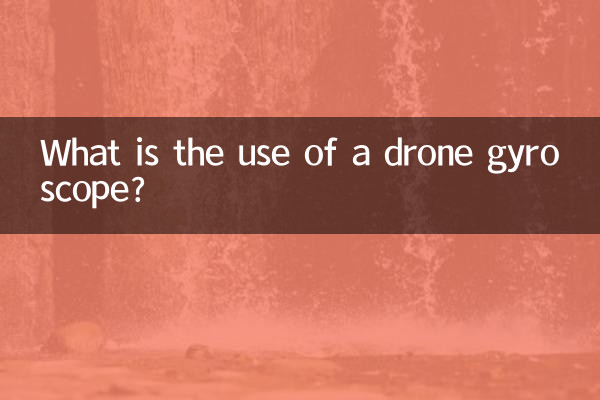What is the use of a drone gyroscope?
The rapid development of drone technology cannot be separated from the support of core components. Among them, gyroscopes, as one of the key sensors, play a crucial role in the stability and handling of drones. This article will analyze the functions, application scenarios and recent hot topics of the gyroscope, and help readers understand its importance more intuitively through structured data.
1. The core functions of the gyroscope

A gyroscope is a device used to measure or maintain direction and works through the principle of conservation of angular momentum. In drones, gyroscopes are mainly used for the following functions:
| Function | describe |
|---|---|
| Stable posture | Real-time detection of the tilt angle of the drone to ensure stable flight |
| Direction control | Auxiliary navigation system, precise control of flight direction |
| Anti-interference | Reduce the influence of external factors such as wind force on flight attitude |
| Automatic hover | Cooperate with the accelerometer to achieve fixed-point hover function |
2. Related recent industry hotspots and gyroscope technology
According to the analysis of popular topics across the network for the past 10 days (data as of November 2023), hot content in the drone field is closely related to gyroscope technology:
| Hot Topics | Relevance | Popularity index |
|---|---|---|
| Commercialization of drone express delivery | high | ★★★★☆ |
| New MEMS gyroscope released | Extremely high | ★★★★★ |
| Agricultural plant protection drone subsidy policy | middle | ★★★☆☆ |
| Drone Racing Championship | high | ★★★★☆ |
3. Gyroscope technology evolution and market data
With the expansion of drone application scenarios, gyroscope technology is also constantly upgrading. Here is a comparison of current mainstream gyroscope types:
| type | Accuracy | Power consumption | cost | Application Level |
|---|---|---|---|---|
| Mechanical gyroscope | middle | high | high | Military/Industrial |
| Fiber Optical Gyro | high | middle | Extremely high | Aerospace |
| MEMS gyroscope | Medium-high | Low | Low | Consumer grade |
4. Analysis of the depth of typical application scenarios
1.Aerial photography: Professional-grade drones are equipped with high-precision gyroscopes, which can keep the screen stable under wind speed of 8m/s, and the gimbal compensation accuracy can reach ±0.01°.
2.Precision agriculture: The plant protection drone maintains a constant flight altitude through a gyroscope to ensure that the uniformity of the application does not exceed 5%.
3.Emergency relief: In complex airflow environments, military-grade gyroscopes can enable drones to maintain attitude control accuracy of ±0.5°.
4.Logistics and transportation: The newly released delivery drone uses a dual redundant gyroscope system, and the failure rate is reduced to 0.001 times/kilometre hours.
5. Technology development trends
According to the industry white paper, gyroscope technology will show the following development directions in the next three years:
| Technical direction | Development focus | Expected breakthrough time |
|---|---|---|
| Chip integration | IMU sensor fusion | 2024 |
| Quantum gyroscope | Navigation level accuracy | 2026 |
| AI Compensation Algorithm | Real-time error correction | 2025 |
Conclusion
As the "balanced brain" of drones, its technological advancements directly determine the performance boundaries of the aircraft. It can be seen from recent hot topics that with the maturity of the MEMS process and algorithm optimization, gyroscopes are developing towards higher accuracy and lower power consumption, which will further expand the application scenarios of drones in commercial, industrial and other fields. In the future, intelligent inertial navigation systems integrating multi-sensor data will become the industry standard.

check the details

check the details